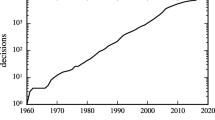Abstract
This investigation has three aims: 1. To direct the attention of scientometrics to the widespread use of citation indexes by practising lawyers. The analysis of this practice is of special value for comparative studies in scientometrics and informetrics. 2. To examine the frequency distribution of legal decision citations in the German jurisdiction. 3. To test whether these frequency distributions depend exclusively on the density of citations between documents of a database, as stated by D. Price.
Résumé
One can find the characteristic distribution regularities of information science in a communication system with similarities, but also great differences to scientific communication systems. The “inverse power law of scientific productivity” of Lotka is — in congruence with a contention ofPrice — true for the “informatory productivity” of legal decisions of some areas of law, if the reception of decisions is measured by the frequency of citations. The slopes of the curves vary with the areas of law (in my investigations roughly between 2.5 and 3.0), and the concentration processes exhibit different velocities. Lotka's formula is not applicable in every case: there seem to be areas of law with a stronger concentration of lower citation scores than permitted by the formula. The slope of the curve in some cases seems to be correlated — asPrice assumed — with the citation density of a database. Here again the income-tax law does not fit to the picture, as in the case of the Lotka law, too.
Similar content being viewed by others
References
R. L. Mott, Status differences among American courts, Repr. from 1936, in:G. Schubert (Ed.),Judicial Behavior, Chicago 1964. p. 287–300.
F. R. Shapiro, Origins of bibliometrics, citation indexing, and citation analysis: the neglected legal literature,Journal of the American Society for Information Science, 43 (1992) 337–339.
S. M. Marx, Citation networks in the law,Jurimetrics Journal, 10 (1970) 121–137.
Therefore one can try to modell this by an economic theory: cf.W. M. Landes, R. A. Posner, Legal precedent: A theoretical and empirical analysis,The Journal of Law & Economics, 19 (1976) 249–307.
K. N. Llewellyn,Präjudizienrecht und Rechtsprechung in Amerika, Leipzig, 1933, p. 49.
Cf.R. Wagner-Döbler, Rechtsprechung und Präjudizien im deutschen Körperschafts-steuerrecht 1950 bis 1992: eine statistische Fallstudie, Rechtstheorie, 24(1993) (forthcoming). Some examples for very slovenly and perfunctory references, however, in:E. Schneider, Belege in den Entscheidungsgründen,Zeitschrift für Zivilprozeß, 77 (1964) 222–253.
Cf.P. Clinch, The use of authority: citation patterns in the English courts,Journal of Documentation, 46 (1990) 287–317.
An example in:R. Wagner-Döbler,op. cit. Rechtsprechung und Präjudizien im deutschen Körperschafts-steuerrecht 1950 bis 1992, note 6.
D. de Solla Price, A general theory of bibliometric and other cumulative advantage processes,Journal of the American Society for Information Science, 27 (1976) 292–306.
R. Wagner-Döbler, L. Philipps, Präjudizien in der Rechtsprechung: statistische Untersuchungen anhand der Zitierpraxis deutscher Gerichte,Rechtstheorie, 23 (1992) 228–241.
R. Wagner-Döbler, Karlsruher Juristische Bibliographie und Juris: ein Vergleich,Informatik und Recht, 3 (1988) 458–461. Id., Fundhefte und Juris: ein quantitativer Vergleich,Computer und Recht, 6 (1990) 412–414.
The time periods were chosen to get an appropriate number of decisions.
Here only decisions of tax tribunals are included: in the other two areas there are some decisions of other tribunals, too.
One cannot totally exclude that the same file number is used by two different courts; but this is extremely seldom. On the other side, if a case has more than one file number, only the first was considered.
For the frequency distribution under consideration the Kolmogorov-Smirnov test can be applied as a goodness of fit test; cf.M. L. Pao, Lotka's law: A testing procedure,Information Processing & Management, 21 (1985) 305–320. The test is carried out with 0.01 significance niveau. The test of the presented table is successful: Column 1/2: Dmax 0.0066<DKS-max 0.0930. Column 3/4: Dmax 0.0219<DKS-max 0.0451. Column 5/6: Dmax 0.0183<DKS-max 0.0347. — To avoid extreme fluctuations, I broke up to register citations in all tables when the rising number of citations interrupted.
Wherey is the frequency in per cent andx the number of “successes”: publications in the context of Lotka, citations in our context. Lotka never stated that the exponent must always be 2. Cf.A. J. Lotka, The frequency distribution of scientific productivity,Journal of the Washington Academy of Sciences, 16 (1926) 317–323.
D. de Solla Price,op. cit., note 9, p. 303.
D. de Solla Price,op. cit., note 9, p. 302. The regression of Price's SCI-data was computed by me. Kolmogorov-Smirnov test: Column 1/2: Dmax 0.0114<DKS-max 0.054. Column 3/4: Dmax 0.0248<DKS-max 0.0437. In the case of SCI the test would be negative because of the largeness of the database. But the abundance of data does not only improve the statistical situation, because now special problems are emerging. For example, it is not clear howPrice solved the problem of authors having identical names; in the SCI as a rule only initials of the surnames are registered.
Author information
Authors and Affiliations
Rights and permissions
About this article
Cite this article
Wagner-Döbler, R. The frequency distribution of legal decision citations in the German jurisdiction. Scientometrics 29, 15–26 (1994). https://doi.org/10.1007/BF02018381
Received:
Issue Date:
DOI: https://doi.org/10.1007/BF02018381




